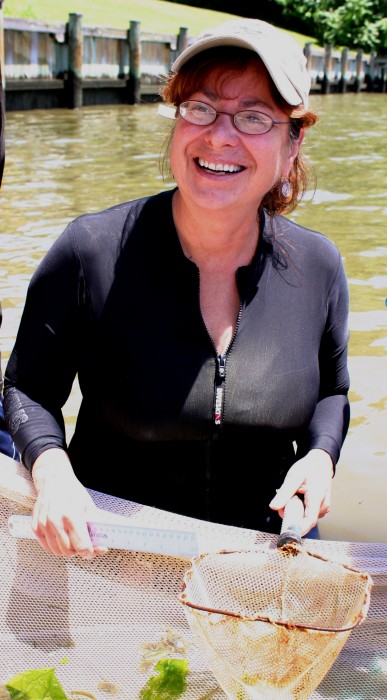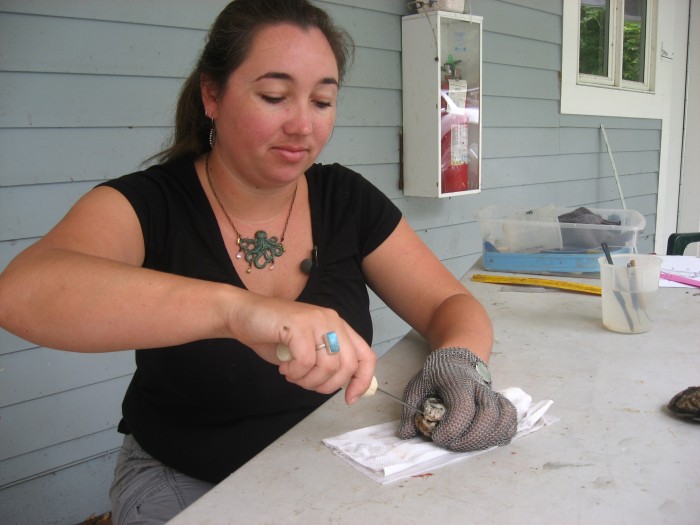Breathing life into the effort to bring back the Bay’s oysters

Slides of oysters suffering different Dermo intensities as the parasite multiplies, from healthy (left) to severely infected (right). (Image courtesy SERC Marine Ecology Lab)
In shallow waters around the world, where nutrient pollution runs high, oxygen levels can plummet to nearly zero at night. Oysters living in these zones are far more likely to pick up the lethal Dermo disease, according to a new study from a team of scientists at the Smithsonian Environmental Research Center.
Oxygen loss in the shallows is a global phenomenon, but the phenomenon is not nearly as well understood as the dead zones that occur in the ocean. Unlike deep-water dead zones, which can persist for months, oxygen in shallow waters fluctuates in day-night cycles, called diel-cycling hypoxia. The cycle works like this: When algae photosynthesize during the day, they release oxygen into the water. But at night, when photosynthesis stops, plants and animals continue to respire and take oxygen from the water, causing dissolved oxygen levels to drop. Nutrient pollution, because it fuels massive algal blooms, can make the cycle extremes more drastic. The resulting lack of oxygen can cripple the oysters’ ability to fight off the parasite Perkinsus marinus that causes Dermo and slowly takes over their bodies.
“We usually think of shallow-water habitats as highly productive refuges from deep-water dead zones,” says Denise Breitburg, marine ecologist at SERC and lead author of the study, published in the journal PLOS ONE. “But if low oxygen makes even these shallow waters inhospitable for fish and shellfish, the whole system may suffer.”
In a field experiment, Breitburg and her colleagues suspended hundreds of eastern oysters (Crassostrea virginica) in underwater cages at 14 sites around the Chesapeake Bay. Young oysters that showed no signs of Dermo infection were used to test the vulnerability of new populations, especially in areas where oyster-bed restoration is a factor. Older, infected oysters were used to test whether low oxygen levels made the disease more severe. After four months, oysters from each site were randomly sampled to to determine the level of Dermo infection.
Across the various sites, infection prevalence ranged from at least half to up to 100 percent. Oysters in areas with more severe low oxygen levels were much more likely to acquire the disease. The disease also advanced to more intense levels in oysters deployed at sites with both low oxygen and salinities at or above 12 parts per thousand. These higher-salinity waters are where Dermo causes extensive mortality in wild populations of oysters.
The researchers followed up their discovery with a more controlled lab experiment to pin down the exact role low oxygen levels play in Dermo infection. In a lab informally called the “Room of DOOM” (Dissolved Oxygen Oyster Mortality), they exposed oysters to low-oxygen cycles similar to those in the bay. Some of the oysters were exposed to constant levels of normal dissolved oxygen concentrations (about 7 milligrams dissolved oxygen/liter); others were exposed to levels that dropped to 1.5 mg/L for a few hours each day and some levels as low as 0.5 mg/L.
Young, uninfected oysters proved to be the most vulnerable in the lab. Young oysters exposed to low oxygen were nearly three times as likely to become infected with the parasite in the first year of the experiment as their counterparts exposed to consistently healthy, high oxygen levels. However, low oxygen levels in the lab did not seem to impact the disease’s intensity. Breitburg suspects this means that other factors play a role in the bay and its estuaries, where acidity, temperature, salinity and food vary from location to location.
But when it came to the oysters’ ability to clean and filter water, the researchers found something surprising. Oysters’ powers of filtration flagged during periods of low oxygen. But during periods of recovery, their abilities bounced back—sometimes reaching even higher levels than oysters that had never experienced low oxygen at all.
“Our results suggest that we will need to think about the effects of even short periods of exposure to low oxygen when choosing sites for oyster restoration,” says Breitburg. “But in spite of the problems we’ve found, these shallow waters may be high-priority candidates. If restoration is done at sufficiently large scales in shallow-water sites, where oysters can access and filter the entire water column, the oysters themselves may be able to transform habitats with water quality that is harmful to oysters to habitats in which oysters thrive.”

In the Room of DOOM, oyster tanks mimic the day-night oxygen swings that oysters experience in shallow Bay waters. (Image courtesy of SERC)
A version of this article was originally published by SERC’s blog, Shorelines
Posted: 12 February 2015
-
Categories:
Environmental Research Center , Feature Stories , Science and Nature





